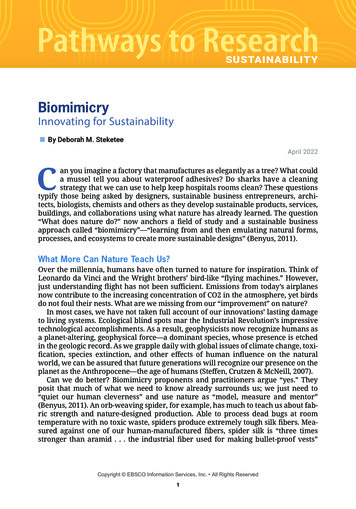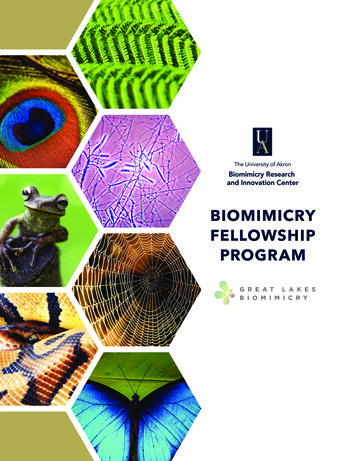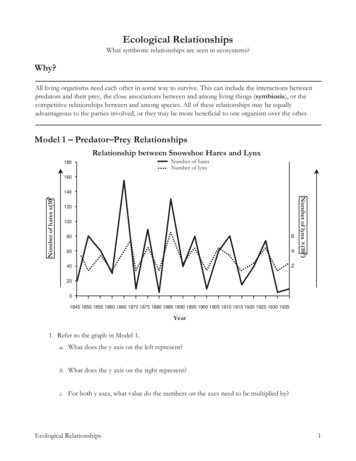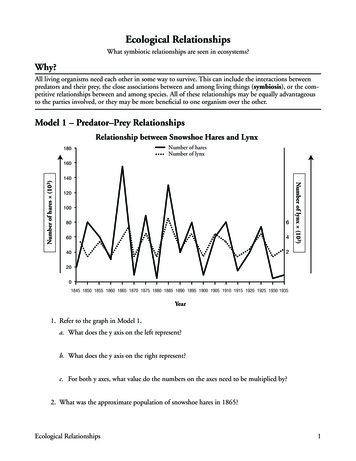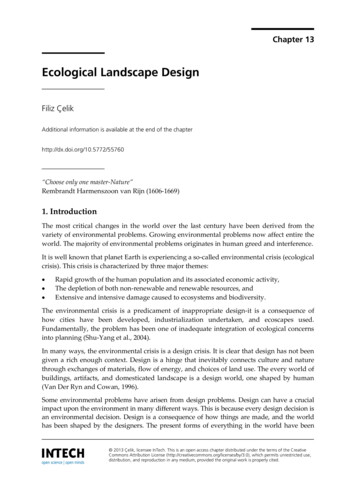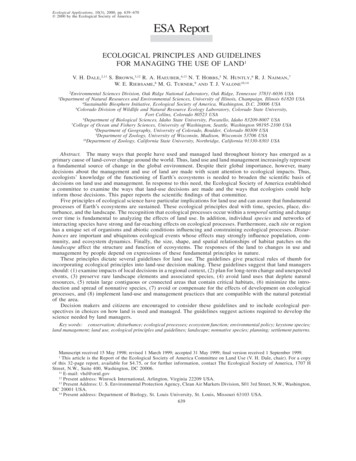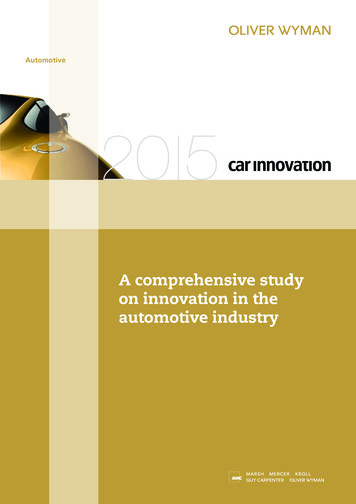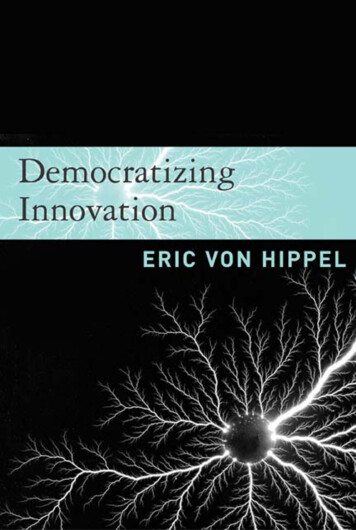
Transcription
J Agric Environ Ethics (2016) 29:203–217DOI 10.1007/s10806-015-9596-1ARTICLESEcological Innovation: Biomimicry as a New Wayof Thinking and Acting EcologicallyVincent Blok1 Bart Gremmen1Accepted: 28 December 2015 / Published online: 7 January 2016 The Author(s) 2016. This article is published with open access at Springerlink.comAbstract In this article, we critically reflect on the concept of biomimicry. On thebasis of an analysis of the concept of biomimicry in the literature and its philosophical origin, we distinguish between a strong and a weaker concept of biomimicry. The strength of the strong concept of biomimicry is that nature is seen as ameasure by which to judge the ethical rightness of our technological innovations,but its weakness is found in questionable presuppositions. These presuppositions areaddressed by the weaker concept of biomimicry, but at the price that it is no longerpossible to distinguish between exploitative and ecological types of technologicalinnovations. We compare both concepts of biomimicry by critically reflecting onfour dimensions of the concept of biomimicry: mimesis, technology, nature, andethics.Keywords Biomimicry Ecological innovation Mimesis Nature as measure Technological innovationIntroductionBecause of growing pressures on resources and the environment, it is increasinglyacknowledged that we have to look for alternatives for the ecosystem destructingtechnologies of the industrial age (cf. European Commission 2012). Consequently,the demand for recyclable and biodegradable materials is increasing. In the contextof the European Union for instance, it is argued that ‘‘in a world with growingpressures on resources and the environment, the EU has no choice but to go for the& Vincent Blokinfo@vincentblok.nl; vincent.blok@wur.nl1School of Social Sciences, Wageningen University, Hollandseweg 1, 6707, KN, Wageningen,The Netherlands123
204V. Blok, B. Gremmentransition to a resource-efficient and ultimately regenerative circular economy’’(European Commission 2012: 1).Over the years, biomimetic approaches to technology and innovation haveincreasingly received attention as such an alternative for the ecosystem destructingtechnologies of the industrial age. Biomimicry or biomimetics is ‘‘a new sciencethat studies nature’s models and then imitates or takes inspiration from these designsand processes to solve human problems’’ (Benyus 2002: I). Nature is seen here as aninspiring source of knowledge—a solar cell inspired by a leaf for instance—whichenables nature-based innovations such as recyclable and biodegradable materials.Other examples include sustainable buildings inspired by self-cooling mounds oftermites or car design inspired by the way trees and bones optimize their strengthand materials.According to the proponents of biomimicry, it introduces a new and ecosystemfriendly approach to nature, which is no longer characterized by the domination andexploitation of nature, but by learning and exploration. Benyus for instance arguesthat the first industrial revolution is characterized by the domination andexploitation of nature, whereas the second—biomimetical—industrial revolutionis characterized by learning from, and exploring, nature. By ‘doing it the naturalway’, our technological innovations can claim to be better embedded in, and inharmony with, the natural ecosystems of planet earth (Benyus 2002; cf. Hawkenet al. 2000). A similar orientation can be found in McDonough and Braungart’sCradle to Cradle approach:Rather than asking, ‘‘How do I meet today’s environmental standards?’’designers would begin to ask, ‘‘How do my design decisions make sense in theoverarching context of the natural world?’’ Ironically, this focus on the earthtakes the green out of green design, for following the laws of nature is simplythe path to good, high-quality design. In the natural world, the processes ofeach organism in a living system contribute to the health of the whole. Oneorganism’s waste is food for another and nutrients and energy flow perpetuallyin closed-loop cycles of growth, decay and rebirth. Understanding theseregenerative qualities empowers us to recognize that all the materials we useas designers—even highly technical, synthetic materials—can also be seen asnutrients. The laws of nature are the bedrock of good design. And theyinform a cohesive set of science-based design practices, which we call Cradleto Cradle Design (McDonough & Braungart 2002).According to the opponents of biomimicry however, the concept is so loose that onemight wonder whether it is more than a slogan forged by chemists in order to play arole in the field of sustainability (cf. Bensaude-Vincent et al. 2002). They doubt thatbiomimicry is a real revolution, and wonder whether it is able to achieve its ambitionsand under which conditions. If the current discussion about the potentiality ofbiomimicry as a new way of thinking and acting ecologically shows one thing, it is thatthe concept itself and its implications are philosophically underdeveloped (cf.Mathews 2011). This is an important omission, because it is possible that biomimicryis implicitly conceptualized in ambiguous ways or in categories—technology versus123
Ecological Innovation: Biomimicry as a New Way of 205nature, discovery versus intervention, (technological) exploitation versus (ecological)exploration, and so on—that hinder its own development.In order to explore the conceptualization of biomimicry as an ecological form oftechnological innovation, we critically reflect on the concept in this article. In‘‘Introduction’’ section, we analyze the elements that constitute the concept ofbiomimicry and its philosophical origin: nature and mimesis. We distinguish astrong and a weaker, but more sophisticated, concept of biomimicry. In ‘‘TwoConcepts of Biomimicry’’ section, we compare both concepts of biomimicry bycritically reflecting on four dimensions of the concept of biomimicry: mimesis,technology, nature, and ethics.Two Concepts of BiomimicryBiomimicry and the Conceptualization of NatureThe first question we would like to address concerns the way the concept of nature ispresupposed in the literature on biomimicry. During the past decades, severalphilosophers and scientists have conceptualized nature in their work on biomimicry.According to Philip Ball, consultant editor of Nature, biomimetics ‘‘decodes andelucidates the cell’s molecular machinery piece by piece’’ (Ball 2001: 413); thismeans that nature is understood here already in a technological way, i.e., as amachine. This idea is confirmed by the materials chemist Julian Vincent, whoconceptualizes nature as ‘‘4 billion years’ worth of R&D’’ (Vincent 2001: 321). In asimilar vein, Benyus argues that nature ‘‘has already solved the problems we arestruggling to solve’’ in a process of ‘‘3.8 billion years of research and development’’(Benyus 2002. Nature is seen here as a huge R&D lab. In a historical study of theconcept of biomimicry, Bensaude-Vincent et al. even argue that nature is seen as anengineer in biomimetic practices: ‘‘Biologists, chemists, physical chemists, andengineers are reunited around a common problem: how can we create, develop,maintain and, eventually, recycle a functional structure with optimal properties?They started to consider nature as an artist, an incomparable engineer from whomwe can learn many lessons’’ (Bensaude-Vincent et al. 2002: 2). In the literature onbiomimicry, nature is therefore seen as an engineer who is involved in an enduringR&D program in order to solve natural problems.It is striking that the ambition of biomimicry is to mimic nature, but that nature isin fact already understood in technological terms—i.e., as ‘‘natural technology’’(Vincent and Mann 2002)—and biomimicry as technology transfer from nature toman (Bensaude-Vincent et al. 2002). We encounter a first ambiguity here regardingthe concept of nature. On the one hand, the concept of nature is rooted in atechnological concept of nature: natural technology or nature as artist, tektoon,techne, technology. On the other hand, the traditional dichotomy between natureand technology is ignored in biomimetical approaches, or, as Ball puts it, inbiomimetical methods of technology and innovation, ‘‘this disparity between thenatural and synthetic art of manufacture begins to diminish’’ (Ball 2001: 413). Werecognize the Marxist position in this line of thought, which argues that all human123
206V. Blok, B. Gremmentechnology is embedded in nature and therefore an expression of nature, whether itis sustainable or not. This first ambiguity raises two questions. On the one hand, it isquestionable whether it is possible to overcome fundamental dichotomies like theone between nature and technology, which is so deeply rooted in our culture andreinvigorates public debates about genetic modification in food production, humanenhancement, and so on (Bensaude-Vincent et al. 2002). On the other hand, andmore important for our current discussion, is the question of what in the end is thedifference between the first and the second industrial revolution if the disparitybetween nature and technology begins to diminish? Given the claim of theproponents of biomimicry that it entails a new approach to technology andinnovation that is embedded in nature and in harmony with the natural ecosystemsof planet earth, it is at least striking that the mimicking of nature is in factmimicking a technological model of nature.The ambiguity between nature and technology in biomimicry is not only at stakein current research; it is also rooted in the philosophical tradition. In his Physics, forinstance, Aristotle explores the concept of nature. Here also however, Aristotle isusing examples from the domain of the techne—the vase, the statue—to understandphusis. In the third chapter of book three for instance, Aristotle introduces fourcauses of natural beings as essential constituents of their physical change (Aristotle194b20–25). However, in exploring the four causes of natural beings, he usestechnological examples like the bronze of the statue as an example of the materialcause, the interval between two notes as an example of the formal cause, thecraftsman who makes the statue as an example of the efficient cause, and exercisingfor the sake of health as an example of the final cause (Aristotle 1980: 194b25–35).This means that Aristotle’s concept of nature in fact presupposes a technologicalunderstanding of nature.This also becomes clear in Aristotle’s equation of technology with nature in hisPhysics. According to Aristotle, both technology (techne) and nature (phusis) areseen as productive (poiesis). The difference between techne and phusis is thatnatural beings have the principle of their productivity in themselves, whereasartefacts are produced by an external agent such as an artist or engineer (Aristotle192b8–34); techne is human production or poiesis by an external agent and phusis isnatural production or self-making (auto-poiesis). Because both techne and phusisare rooted in poiesis, both are essentially the same according to Aristotle (cf.Aristotle 199a10–20).1 However, the decision to think of nature in terms of poiesisalready implies that nature is understood in technological terms, namely, in terms ofits productivity or makeability (cf. Heidegger 1999: 88).The first conclusion we can draw, therefore, is that the identity of techne andphusis in the Aristotelian tradition can be seen as the philosophical origin of thetechnological conceptualization of nature in the literature on biomimicry. Both theAristotelian tradition and current biomimetic research presuppose a technologicalconcept of nature and are therefore incapable of conceptualizing nature qua nature(see ‘‘Two Concepts of Biomimicry’’ section).1In the next section, we explore an additional argument as to why, according to Aristotle, nature andtechnology are essentially the same.123
Ecological Innovation: Biomimicry as a New Way of 207Biomimicry and the Conceptualization of MimesisWe leave now for a moment the technological concept of nature which ispresupposed in Aristotle’s philosophy, and turn to the way he explicitlyconceptualized the relation between techne and phusis. The reason for this is thatin Aristotle’s Physics, we can also find the classical definition of the concept ofmimesis. According to Aristotle, techne and phusis are essentially the same not onlybecause both are rooted in poiesis (cf. section 1.1), but also because technologymimics nature (Aristotle 194a20–25). The techne either—on the basis of thephusis—accomplishes or perfects what phusis is not capable of effectuating itself, orimitates (mimeitai—mimesis) phusis (Aristotle 199a20–25). There are, therefore,two types of the technological mimesis of nature according to Aristotle. First of all,there is the mimetic copy or reproduction of the naturally given, which we could callthe naturalistic concept of mimicry with which we are familiar. It is, however,important to acknowledge that Aristotle distinguishes also another type of mimesis,which is based on the deficiency of nature. Nature is not capable of producing oreffectuating everything, and, in this case, mimicry productively supplements thecapabilities of nature (cf. Lacoue-Labarthe 1998). Which one of both types ofmimesis is used in the literature on biomimicry and which of both types issuitable to be used in the second—biomimetic—industrial revolution?According to some proponents of biomimicry, mimicry is not the exploitation ofbiomaterials for technological applications, but consists in learning from andexploring nature (cf. Benyus 2002). Biomimetical scientists try to ‘‘elucidate howlife creates complex hierarchical structures, integrating many functions, tounderstand chemical and physical strategies employed by living systems in orderto apply them, with suitable modifications, to the field of technological design’’(Bensaude-Vincent et al. 2002: 2). Rather than inventing new technologies,biomimicry discovers natural processes and applies these processes in ourtechnological design. Can we claim that Benyus cum suis opt for biomimicry as acopy or reproduction of natural processes and that they therefore embrace thenaturalistic concept of biomimicry? In fact, we have to distinguish between a strongand a weaker concept of biomimicry.The strong concept of biomimicry is represented by Janine Benyus. Sheconceptualizes biomimicry in a naturalistic way as imitation of nature’s models inorder to solve human problems. The main objective of biomimicry is to ‘‘echo’’ theideas of nature in our own lives: biomimetic scientists ‘‘are exploring nature’smasterpieces—photosynthesis, self-assembly, natural selection, self-sustainingecosystems, eyes and ears and skin and shells, talking neurons, natural medicines,and more—and then copying these designs and manufacturing processes to solveour own problems. I call their quest biomimicry—the conscious emulation of life’sgenius. Innovation inspired by nature’’ (Benyus 2002: 4–5). Although mimicry isinspired by nature, this inspiration is primarily understood as discovery andimitation of nature and represents therefore the naturalistic concept of mimicry thatwe find in Aristotle’s Physics.This strong concept of biomimicry is, according to Benyus, partly motivated bythe idea that nature is a measure to judge the ethical rightness of our technological123
208V. Blok, B. Gremmeninnovations (Benyus 2002). Because natural principles are assumed to be principlesthat conduce to ecological health and integrity of the ecosystems of planet earth,biomimetic technology and innovation can claim to be ethically right.2 By using thesame design principles as natural entities and systems, and by modelling ourtechnological design on natural principles, biomimicry adheres to a bioinclusiveethics that enables us to resituate our technological design within the ecologicallimits of the biosphere: ‘‘If we as human beings are to ‘act from within nature’, asthe ethos of biomimicry implies we ought, then the requirement of recursivenessapplies to us, to our agency. We must allow our ends as well as our means, ourdesigns, to be shaped by who and what is out there in our environment’’ (Mathews2011: 373). In this respect, the strong concept of biomimicry includes nature asnormative principle of the conduciveness to ecological health and integrity as designprinciple, i.e. as a standard of ecological ethics, contrary to conceptualizations ofbiomimicry that exclusively look at these principles of nature in mechanistic terms(we come back on this conceptualization of biomimicry in a moment).In order to adhere to natural principles as a normative standard of technology anddesign, however, mimicry has to be understood in the strict sense of an copying oran reproduction of nature. On the one hand, by copying or echoing the designprinciples of nature, our technological innovations can claim to be more ‘natural’and to be more ‘adaptive’ to the capacities of the biosphere (Benyus 2002). On theother hand, our biomimetic designs can only claim to be ethically advantageous ifthey really have copied these natural principles. In other words, because biomimicryis understood in the strong sense as copy or reproduction of natural processes,Benyus cum suis can claim biomimicry to be bioinclusive and ethically ‘right.’There are, however, at least three presuppositions in this strong concept ofmimesis in biomimicry, all three of which are questionable. First, a strong conceptof biomimicry presupposes a strict distinction between the mere discovery ofentities or systems that already exist—natural principles—, which are copied, andthe invention of newly created things like artefacts, which are invented. This strictdistinction is already questionable from an Aristotelian perspective, becausemimesis concerns not only the imitation or reproduction of what is given in nature aswe have seen, but also the supplementary perfection of what nature is not capable ofproducing itself. This difficulty in distinguishing between discovery and invention isalso confirmed by Godin’s (2008) history of the concept of innovation: The idea ofnovelty is indeed key in the concept of invention in contrast to the concept ofimitation, but invention can be used both for finding and for making. Finally, if weacknowledge the theory-ladenness of perception (Popper 1974), we have to admitthat every discovery, just like every invention, already involves a construction.2The assumption that natural principles conduce to ecological health does not imply that non-naturalprinciples necessarily conduce to un-healthy eco-systems. It is principally possible to discover designprinciples that cannot be found in nature but nevertheless conduce to ecological health, and with this, it isprincipally possible to design technologies and innovations based on non-natural principles, which canclaim to be ethically right. But this is not an argument against the claim of the strong concept ofbiomimicry that biomimetic innovations are ethically right. Proponents of a strong concept of biomimicrydo not have to deny this possibility of a non-natural measure to judge the ethical rightness oftechnological innovations. They only argue that natural principles conduce to ecological health, andtherefore, that biomimetic technologies and innovations can claim to be ethically right as well.123
Ecological Innovation: Biomimicry as a New Way of 209A second presupposition of the strong concept of biomimicry is our epistemicsufficiency to ‘know’ the designs of nature; in order to ‘echo the ideas of nature’ orto ‘borrow designs from the larger life system’, we should be able to have fullaccess to nature, to be able to understand and know the natural processes itself. It isquestionable, however, whether natural processes are fully accessible and understandable for us. The complexity and temperamentality of natural phenomena limitthe possibility of our discovering and then echoing nature’s models to solvetechnological problems (cf. Bensaude-Vincent et al. 2002).A third presupposition of the strong concept of biomimicry is a strict distinctionbetween the technological intervention in nature—the exploitation of the firstindustrial revolution—and the pure receptivity of nature—the sensing and learningfrom nature of the second industrial revolution. If we acknowledge the complexityand temperamentality of nature, we also have to acknowledge the necessity totranslate and interpret natural phenomena in order to explore their applicability inthe context of technological problems. With the introduction of the concept oftranslation and interpretation however, the ethical advantage of biomimetical designbecomes questionable, because a strict distinction between reproduction andinvention can no longer be made.Because of the questionability of these three presuppositions of the strongconcept of biomimicry, we turn now to a weaker, but more sophisticated concept ofbiomimicry like that developed by Joanna Aizenberg, co-director of the KavliInstitute for Bionano Science and Technology at Harvard University. During aTED3 talk on March 5, 2012, she introduced biomimetics as a strategy ‘‘to mimichigh-tech solutions that nature can give us, reformulate natural materials, naturalstrategies and to create new materials and devices that outperform anything that wehave today’’ (Aizenberg Ted 2012). For the sophisticated concept of biomimicry,mimicry does not consist of the reproduction or duplication of natural solutions;rather, these natural solutions are taken as inspiration to create new materials anddevices, or as Bensaude-Vincent et al. put it: ‘‘biomimetism is more a question ofinspiration in the poetic sense, that is the intention of original forms or processesstarting from a natural motive that solved a similar problem [by] either borrowingdirectly from living things, or mimicking nature’s structures, function andprocesses ’’ (Bensaude-Vincent et al. 2002).Contrary to the first presupposition of the strong concept of biomimicry, theweaker concept sees mimicry not as the duplication of natural solutions, butprimarily as a creative solution inspired by nature (cf. Ball 2001). Contrary to thesecond and the third presupposition of the strong concept, the weaker conceptacknowledges that ‘‘some form or procedure of interpretation or translation frombiology to technology is required’’ (cf. Vincent et al. 2006). In the weaker conceptof biomimicry therefore, the complexity and temperamentality of natural phenomena are acknowledged, as well as the necessity of translation in order to transfernatural problem solving to technological problem solving.3TED (Technology, Entertainment, Design) is a non-profit organization whose stated aim is to makegreat ideas accessible and spark conversation (www.ted.com).123
210V. Blok, B. GremmenThis raises the critical question of what happens to our hope for a newbiomimetic approach to nature that no longer dominates and exploits nature if weembrace the weaker concept of biomimicry. Is there still a difference betweentraditional technology characterized by the exploitation of nature and biomimeticaltechnology, if nature is no longer the model and ethical standard of ourtechnological innovations, but is just understood in mechanical terms? What, inother words, is the difference between the first and the second industrial revolutionif biomimicry is understood in this weaker sense of the word? The weaker conceptof biomimicry cannot claim to imply a bioinclusive ethics like the strong concept ofbiomimicry. On the contrary, the weaker concept does not take natural principles asa normative standard, but focuses on the re-creation of nature for human ends. In theweaker concept of mimicry, nature is considered purely as a ‘‘storehouse ofreadymade designs available for us to mix and match to our consumer purposes’’(Mathews 2011: 373), i.e., as a resource for useful ends and purposes (cf. Schyfter2012). With the introduction of a weaker but more sophisticated concept ofbiomimicry, the specific advantages of biomimicry as learning from nature overtechnology as exploitation of nature threatens to fade away.Before we can answer the question of which one of both types of biomimicry issuitable to be used in the second—biomimetic—industrial revolution, we comparethem by critically reflecting on four dimensions of the concept of biomimicry in thenext section: mimesis, nature, technology, and ethics.Strong- and Weak Biomimicry ComparedMimicryAs we have seen in the previous section, the concept of mimicry cannot beunderstood from classical oppositions like discovery versus invention. In theAristotelian tradition, mimicry is not only the mechanical imitation of nature as it isdiscovered (nature as model), but also the aemulatio or perfection of this model, i.e.,an ‘invention’ (poiesis). However, mimicry cannot be understood as an inventioninspired by nature, because mimicry can only be an aemulatio or perfection ofnature if it is in fact oriented on nature as model. The distinction between discoveryand invention does not help to characterize the nature of bio-mimicry and seems tointroduce a completely new category.The French philosopher Lacoue-Labarthe has extensively reflected on theconcept of mimesis (Lacoue-Labarte 1990, 1998). According to Lacoue-Labarthe,mimesis is not a completely new invention, because it perfects what is already in acertain way but what is not at the same time: nature. Why? If it already existedcompletely, it would not have to be perfected by a technological mimesis. So, on theone hand, mimesis mimics what already exists, and, on the other hand, it only existsin the strict sense of the word because of this mimicking activity of the techne.Lacoue-Labarthe conceptualizes this relation between techne and phusis in termsof an original supplementarity (Lacoue-Labarte 1990: 58ff). The techne bringssomething new to the mimesis of nature, a supplement, and only this technological123
Ecological Innovation: Biomimicry as a New Way of 211supplement provides access to phusis as the origin of the mimesis according toLacoue-Labarthe, because a perfection of phusis by techne implies a deficiency ofnature. Nature is deficient because it cannot produce everything and has to beperfected by technology. On the basis of Heraclitus’ famous thesis that nature hasthe tendency to conceal itself, we can conceptualize this deficiency of the phusis asthe tendency of nature to conceal itself, and therefore nature has to be supplementedby a technological re-presentation in order to appear for us (cf. Blok 2014a;Heidegger 2000). As such a re-presentation of phusis, the technological mimesis hasto be understood as an addition or supplement to the original phusis. At the sametime, this re-presentation is constitutive of our experience of the phusis. Becausephusis has the tendency to conceal itself, only a technical supplement or representation of the phusis is able to give us access to this original phusis, accordingto Lacoue-Labarthe. Mimesis is therefore not only a reproduction of the originalphusis but at the same time constitutive of this original. In this respect, LacoueLabarthe calls the techne and the phusis co-original (cf. Peperstraten 2005).What this brief consultation of Lacoue-Labarthe’s concept of mimesis alreadymakes clear is that the concept of mimesis is theoretically underdeveloped in thecurrent literature on biomimcry, but that its conceptual analysis could providepossible guidelines for future research in the field of biomimicry. The concept ofsupplementarity could, for instance, be helpful in biomimetic practices, because itcan help us to reconsider the dichotomy between reception and discovery on the onehand and invention and intervention on the other. Biomimicry is then not thediscovery of nature’s model and the copying of natural processes in ourtechnological designs, as is claimed by the strong concept of biomimicry. Thisperspective is highly naı̈ve, because successful copying of nature is quite rare; theimitation of the wing of a bird for instance does not result in the ability to fly, as thehistory of aerodynamic techniques clearly shows (Vogel 1998). The question is,however, how such a supplementarity of the concept of biomimicry has to beunderstood in practice, and what the consequences are for the idea that biomimeticalinnovations are better embedded in, and in harmony with, the ecosystems of planetearth.NatureAs we have seen already in ‘‘Introduction’’ section, the concept of nature which ispresupposed in both the philosophical tradition and the literature on biomimicry is atechnological model of nature; nature is understood in technological terms asproductive and makeable. According to the strong concept of biomimicry, theproduction of nature is already perfect and should be reproduced in biomimetictechnologies; the technologies of the first industrial revolution are imperfect andshould be perfected by the second industrial revolution by mimicking nature.Mathews for instance argues: ‘‘If we as human beings are to ‘act from withinnature’, as the ethos of biomimicry implies we ought, then the requirement ofrecursiveness applies to us, to our agency. We must allow our ends as well as ourmeans, our designs, to be shaped by who and what is out there in our environment’’(Mathews 2011: 373). At the same time, we have seen in ‘‘Biomimicry and the123
212V. Blok, B. GremmenConceptualization of Nature’’ section that the conceptualization of biomimicry asreproduction of nature is highly naı̈ve and that all mimicry involves a supplement orre-production of nature’s productivity. So nontheless the ambition of the strongconcept of biomimicry to re-produce the perfection of nature, such a pure reproduction is highly naı̈ve and also impossible, given the sup-plementary characterof all mimesis. This supplementarity of mi
to Cradle Design (McDonough & Braungart 2002). According to the opponents of biomimicry however, the concept is so loose that one . In the third chapter of book three for instance, Aristotle introduces four causes of natural beings as essential constituents of their physical change (Aristotle 194b20-25). However, in exploring the four .
